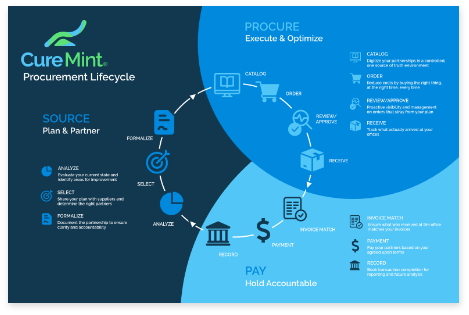At CureMint, we’re committed to driving down costs as we help your dental organization reshape its supply procurement strategy. In this blog series, we’ll guide you through nine easy steps to drive down your dental supply expenses so you can better manage your finances and become more profitable in the dental industry.
After the flurry of activity we saw in Step Three, this portion of our nine-step process might seem like a step back. But when reviewing offers, you need to take some time to collect yourself and compare your options.
Though it may seem boring on the tin, reviewing all the data is a rather dramatic step in this journey. Here’s where the foundation for future consolidation begins. It’s when you start deciding who will receive your business. Again, you’ll be glad you’ve already done all that homework and research in the primary phases of this process, as we can calculate on a granular price-per-unit level who’s offering the clearest savings for your practice. Along with upfront pricing, other factors should be considered during data review when determining how to move forward and which vendors genuinely offer the best holistic deal for your dental organization.
With that, let’s jump right into it.
STEP FOUR: REVIEW ALL THE DATA
We last left off with counter-offers from suppliers and manufacturers, seeing who will get most aggressive with their pricing to gain or retain your business. By now, you may be able to predict what we’ll do with this information as it trickles in: Plug it all into your master spreadsheet!
[Get access to the master spreadsheet in the full 9 Step Guide]
You’ll want to make apples-to-apples cost comparisons between these new price schedules, your old supply cost data, and the proposed prices you’ll receive from different vendors and manufacturers. Using the latest prices from all these collected quotations starts by breaking down each product’s price-per-unit cost. Once you’ve completed those calculations, you can then map out your potential savings by referencing these new pricing schedules side by side. With all the possible deals lined up, you quickly determine where you’re possibly able to consolidate your spending, whether that’s between brands or vendors.

You’ll plainly see who’s hungriest for your business once you have all these new quoted costs laid out in front of you. However, recall that we asked for possible side perks from each supplier when we sent out those RFQs. Compared to the easily quantifiable differences in price, these benefits might seem more intangible than just saving more money upfront, but they should never be discounted.
If you’ve done your due diligence during RFQs, you’ll recall deal sweeteners offered by different manufacturers, like volume-discount ladders, rebates, training, and continuing education allowances. All those factors combined with the lowered price schedules will be worth your consideration, and if you’re facing a dilemma between two potential deals, these side perks may help tip the scales toward one vendor over another. Depending on your organization, these considerable benefits may even help you save money in other avenues aside from face-value supply costs. Though the focus of this series has been on streamlining and reducing your supply costs, you can see in the current review stage how this entire process holds the potential to help your dental organization save money in other areas.
You now know which products will deliver the quickest, most significant savings on your dental organization’s supplies. You’ve also begun figuring out which suppliers and vendors might prove to be your most beneficial business partners. To establish which product is best for your offices, however, we’ll have to test them out in the real world with the people who’ll use each product every day. But we’re saving that critical phase of our nine-step process for next time.
Keep a lookout for Part Five: How to Conduct Product Trials Efficiently & Effectively
Can’t wait for the next blog? We don’t blame you! Download the full guide to get immediate access to Step 5.
Related Blogs
How to Get Started with Dental Spend Management When You Don’t Know Where to Start
09.30.21
For rapidly growing dental service organizations (DSOs), the…
Using Big Data to Lower Dental Supply Costs
09.28.21
As the dental market surpasses $150 billion and private…
Not All Dental Costs Are Equal: Which One Are You Focusing On?
09.27.21
It doesn’t matter whether you’re whitening teeth or selling…





